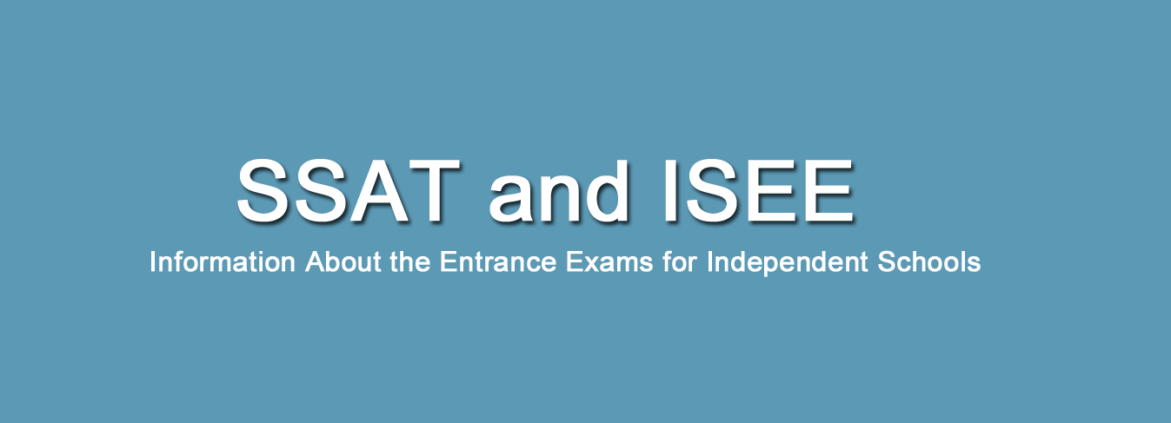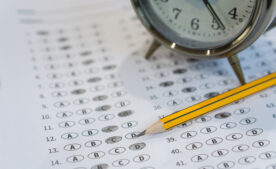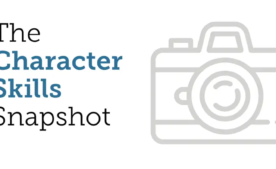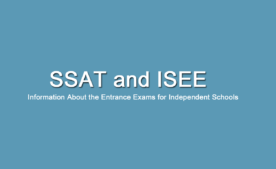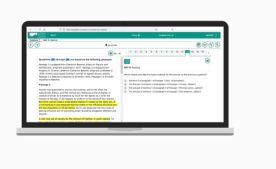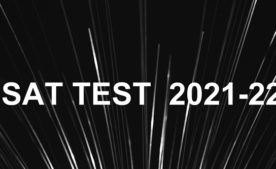Once families have embarked on the search for an independent school, they often wonder whether to take the SSAT or ISEE. Depending on where you are applying, you may or may not have a choice. Upper schools often have a preference for the SSAT, and middle schools often prefer the ISEE, but many schools have no preference and will accept either test. Here we outline the differences in test structure, scoring, content, scheduling, and delivery between the SSAT and ISEE.
Overview
Neither test is easier or harder than the other. Most students score comparably on both tests. However, some students perform significantly better on one test or have a strong personal preference.
When choosing between the SSAT and ISEE, consider the tests’ content as well as your confidence and comfort with the format and material. Do not try to prepare for both of the tests at the same time; by overstretching yourself, you will prevent yourself from performing up to your potential on either test.
Early in the application process, craft a testing plan that addresses which tests you are going to take, when you’re going to take them, and how and when you are going to prepare for them.
Start by taking a practice test. If you have the choice between sending SSAT or ISEE scores, we recommend taking one of both practice tests. Use your practice test scores and your preference for the different features of the test to decide whether SSAT or ISEE will be the focus of your test preparation.
Format and Length
Test Sections — The SSAT and ISEE have similar structures. Both tests feature math, reading, and verbal sections. Additionally, both tests feature an unscored writing sample, which is sent directly to schools. The Lower Level ISEE and Elementary Level SSAT are 2 hours long, and the Middle/Upper Level SSAT and ISEE are 3 hours long.
Pacing — The average time per question is almost identical on either test. The major exception is for the math sections, where the SSAT offers slightly more time per question.
Experimental Questions — The SSAT may include an experimental section at the end of the exam. This section includes unscored questions that are being tested for future SSAT forms. The ISEE also includes experimental questions but spreads them throughout the test.
Scoring
Guessing Penalty — The SSAT penalizes students ¼ raw point for incorrect answers. Therefore, students must be more careful about guessing on questions. The ISEE has no penalty for incorrect answers, so students should guess aggressively and never leave an answer blank.
Relative Weight — The SSAT and ISEE place different relative weight on the math and English scores. The SSAT reports two English scores (Verbal and Reading Comprehension) and one math score. The ISEE reports two English scores (Verbal Reasoning and Reading Comprehension) and two math scores (Quantitative Reasoning and Mathematics Achievement). Students who feel anxious about their math skills may prefer the SSAT, which has only one of its three section scores based on math. In comparison, half of the ISEE’s section scores are based on math.
Scores — Score results are available between 2 and 10 days following the test, depending on the test delivery method. Both tests convert raw scores to scaled scores, which are then given percentile ranks based on the student’s ranking among other test-takers. In addition to percentiles, the ISEE also gives a stanine score. Independent school admission offices have historically relied more on percentile ranks in SSAT and ISEE scores.
Your SSAT or ISEE percentile ranks may be lower than expected. Rest assured that schools understand the competitive nature of the SSAT and ISEE. Your test preparation can help improve your standing among this group of test-takers.
Math
Scope — The SSAT and ISEE have similar scopes of math concepts that are tested. Both tests focus primarily on arithmetic, algebra, and geometry. The Upper Level ISEE may include more advanced concepts, such as trigonometry.
Straightforward vs Abstract — Many of the math questions on the SSAT are different from what students see in standard math courses. SSAT math questions can be abstract and complex, requiring problem-solving and critical-thinking skills. The ISEE’s Quantitative Reasoning section also has abstract and complex questions, while the ISEE’s Mathematics Achievement section has more straightforward, curriculum-based questions.
Reading
Length — SSAT reading passages are typically 250-350 words long. ISEE passages are typically longer, about 300-600 words long.
Prose and Poetry — The ISEE Reading Comprehension passages cover topics related to history, science, literature, and contemporary life. The SSAT covers similar topics, but the SSAT may also include poetry passages.
Verbal
Analogies vs Sentence Completions — The SSAT Verbal section includes analogies, which require you to determine the relationship between words. These questions are a test of vocabulary and critical thinking. The ISEE Verbal Reasoning section includes sentence completions, which require you to determine which word fits best within a given sentence. These questions generally require a stronger vocabulary than the SSAT’s analogies, but also require less critical thinking.
Writing
While the SSAT and ISEE essays are not scored, they are sent to the school admission committees, and it can still be an important part of your application.
Length – The SSAT writing section is 25 minutes (15 for the Elementary Level) and the ISEE writing section is 30 minutes.
Essay Prompts — For the Upper Level SSAT, you have a choice between a personal prompt and a general prompt. The personal prompt asks about a topic related to your interests or personality. The general prompt asks a question that is somewhat philosophical so you can share your views and values. For lower levels of the SSAT, the choice is between a personal prompt and a creative prompt. The creative prompt serves as an inspiration for a short story. For all levels of the ISEE, you are given a single personal prompt.
Scheduling
Testing Season/Testing Windows – The test makers have defined time frames during which students may take the official test that will be used in their applications to schools. In the case of the SSAT, the Enrollment Management Association has established its testing season as August 1st through July 31st. The Education Records Bureau, makers of the ISEE, has established testing windows and has limited students to testing once per 4-month window. The ISEE testing windows are Fall (August through November), Winter (December through March), and Spring/Summer (April through July).
Delivery Modes – SSAT test-takers can take the test any of four ways, each with a specified limit on the number of times students can use the delivery mode: (1) paper-based tests on standard test dates at school test sites, (2) computer-based at a Prometric test center, (3) computer-based from home via live, virtual proctor and (4) paper-based Flex tests with an educational consultant.
However, the ISEE uses a different approach to test-taking limits students, allowing one test per “testing window” regardless of the delivery mode. ISEE test-takers have 3 options: (1) Paper-based tests at approved testing sites. (2) computer-based tests at a Prometric test center or (3) computer-based from home via a live, virtual proctor.
Practice Tests with Summit
We highly recommend that students start by taking one of our free practice SSAT or ISEE (both, if you are given the choice). You’ll receive a detailed Score Report that will pinpoint strengths and areas for development. As a complimentary service, we’ll walk you through the analysis, answer your questions, and provide guidance for test planning. With the score results and experience in mind, students and families can then make informed decisions about which test to take and how much preparation to plan for.
You can take both paper- and computer-based practice SSAT and ISEE with Summit. Practice tests should be taken in the same delivery-mode that official tests will be done. For students who plan on taking the paper-based test, we have physical tests and students will take them using a bubble answer sheet.
Our digital testing platform provides an excellent simulation of the format and test-taking tools that appear on the official computer-based tests. It is crucial that students become familiar with the digital testing experience prior to their testing day. Summit’s digital practice tests are a good way to build that familiarity in a low-stress practice test.
Summit works hard to keep you current on all of the changes in the testing environment. In addition to providing exceptional test preparation and personalized tutoring, we strive to be a trusted, expert resource for counselors and families navigating the process. If you are looking for professional, thoughtful, personal guidance, experienced tutors, and customized test preparation, we are here for you. Our commitment is to your testing success, on your terms. Contact us if we can help in any way.
